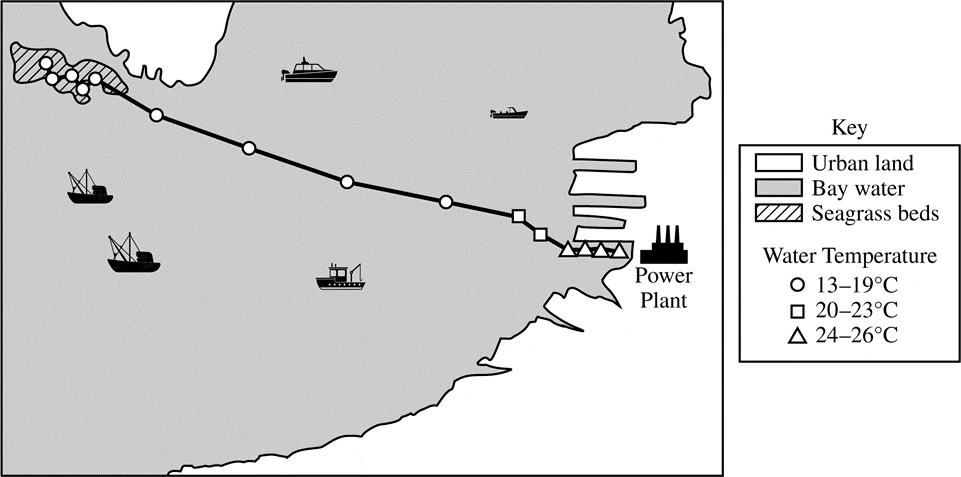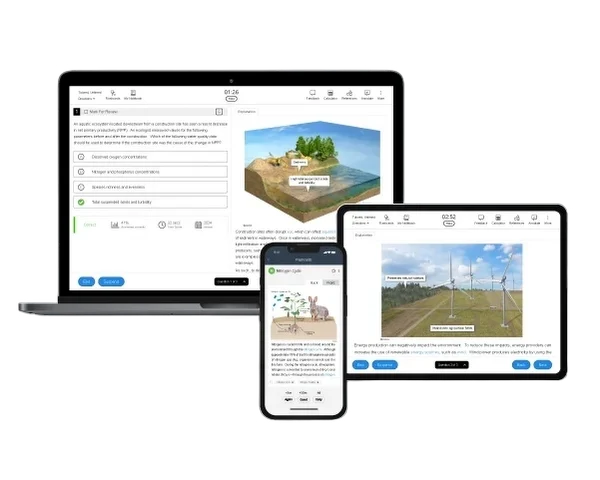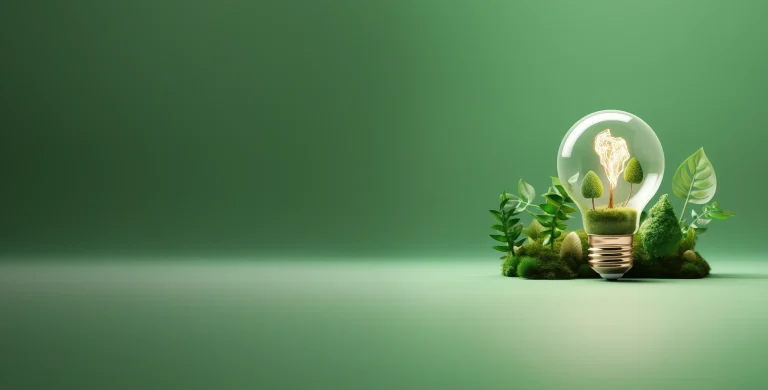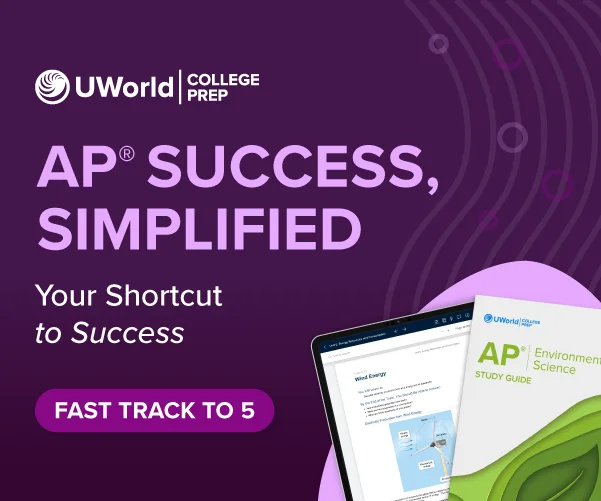The AP® Environmental Science (APES) free-response questions (FRQs) are an important part of the exam, making up 40% of your total score. Understanding the structure of these questions, knowing how to approach them effectively, and practicing can greatly improve your performance.
The FRQ section of the AP Environmental Science exam is allotted 1 hour and 10 minutes, giving you approximately 23 minutes per question. Since Section 2 accounts for 40% of the overall score, performing well here is crucial for achieving a high score on the exam. You will encounter the following types of questions in this section:
| Question | Question Type | Points |
|---|---|---|
| FRQ 1 | Design an investigation | 10 |
| FRQ 2 | Analyze an environmental problem and propose a solution | 10 |
| FRQ 3 | Analyze an environmental problem and propose a solution doing calculations | 10 |
Our AP Environmental Science Study Guide, available in print and digital formats, provides expert strategies, step-by-step solutions, and real-world examples to help you excel.
How to Answer AP Environmental Science FRQs
Here are some essential tips and strategies for answering APES FRQs:
-
Writing techniques to maximize your score
When answering FRQs, remember that each response is scored based on predetermined rubrics called scoring guidelines. Your answers should be clear and concise and include specific examples to demonstrate your knowledge. Follow these tips to maximize your score:
- Label each part of the question you are answering (Ai, Aii, Bi, etc.) instead of writing in 1 long paragraph.
- Leave space between each labeled part of the question if you need to add more information later.
- Provide only 1 example if the question asks for it. If you give multiple examples, you will only receive credit for the first one, even if later examples are correct. Additionally, if the later examples contradict the first, you may lose points.
- Avoid restating the question. You won't get credit for repeating what's already in the question. Instead, provide unique, detailed responses with specific examples to demonstrate your understanding. Avoid vague terms such as “good for the environment,” “greener,” or “toxic.” For instance, instead of saying “DDT is toxic,” explain why it is toxic: "DDT is an endocrine disruptor that causes thinning of birds of prey eggshells."
- Tailor your answers: For economic-related questions, discuss money, jobs, or tourism. For societal factors, focus on human impact. For environmental factors, discuss living and nonliving components but exclude human factors.
-
Know how to answer questions based on task verbs
Each FRQ contains task verbs that are bolded to indicate the type of response required. Here's how to handle the most common task verbs:
- Identify: Provide a clear, single-sentence answer. If the question asks for a value from a graph, give the specific number (not a range or approximation). If asked for a range, provide both the starting and ending values.
- Describe: Provide a concise answer in 1 or 2 sentences, offering key details related to the topic. For example, if asked about a specific process, explain its key aspects, such as the products formed or conditions necessary for the process.
- Explain: Answer in 2 or 3 sentences, detailing how or why a situation occurs.
- Calculate: Show your mathematical work step-by-step. Do not simply provide the answer in words. Include the formula, the values used, and the units. If you skip any of these steps, you won't receive points. Refer to the AP Environmental Science formula sheet for essential equations
- Make a Claim: Provide a brief, 1-sentence prediction based on the data and content knowledge.
- Justify: Support your claim in 2 or 3 sentences, using evidence from the provided data or your content knowledge to explain why the claim is correct.
- Propose a Solution: Offer a realistic solution to the environmental issue presented. Avoid suggesting laws or bans, as these are often unrealistic due to time and feasibility constraints.
- Read the questions carefully
Carefully read each question to ensure you know what to include and what to exclude in your answers. Underline important details, such as task verbs, values, units, and any specific instructions. After writing your response, re-read the question to confirm that you've addressed all necessary points and avoided unnecessary information.
Our AP Environmental Science Online Course includes expert-designed practice questions and in-depth explanations to help you sharpen your responses.
Example AP Environmental Science FRQs
Although each APES FRQ will use the same task verbs such as identify, describe, or explain to check your knowledge related to the given prompt, they will require different approaches while answering the question. Below are examples of each AP Environmental Science free-response question on the exam.
FRQ 1
Directions: Answer all three questions, which are weighted equally; the suggested time is about 22 minutes for answering each question. Write all your answers in the Free Response booklet. Where calculations are required, clearly show how you arrived at your answer. Where explanation or discussion is required, support your answers with relevant information and/or specific examples. You may plan your answers in this orange booklet, but no credit will be given for anything written in this booklet. You will only earn credit for what you write in the separate Free Response booklet.
Below is FRQ 1 on Set 1 from the released 2023 APES exam questions on the College Board® website.
1. Researchers interested in sustainability developed three new varieties of genetically modified green beans designed to produce higher yields in arid regions. Four plots (A–D) were set up on a floodplain of a river to grow beans. Plots A, B, and C were each planted with seeds of different types of genetically modified strains of green beans. Plot D was planted with seeds of unmodified green beans. Each plot was given equal amounts of fertilizer, which contains phosphorus and nitrogen, and water and was irrigated using spray irrigation for one hour per day. Throughout the growing season, researchers measured the amount of green beans harvested within each plot. The plots with genetically modified beans had higher crop yields than the plot with unmodified beans.
- Identify the control group in this experiment.
- Identify the scientific question for the investigation.
- Researchers repeated the experiment by modifying the length of time for the spray irrigation to 20 minutes per day. Explain how the results of the experiment could be altered with this modification.
Researchers also monitored the amount of sediment and fertilizer washing into the river from each plot in the original study. The soil temperature was also measured in each plot at the same depth and at the same time each day, approximately 0.05 meters below the surface of the soil.
| Plot | Sediment Runoff (mg/L) |
Phosphorus Runoff (mg/L) |
Nitrogen Runoff (mg/L) |
Soil Temperature (°C) |
|---|---|---|---|---|
| A (Type 1 GMO beans) | 2.4 | 0.11 | 1.07 | 18.6 |
| B (Type 2 GMO beans) | 2.1 | 0.02 | 0.56 | 18.3 |
| C (Type 3 GMO beans) | 0.9 | 0.04 | 0.68 | 18.3 |
| D (Unmodified beans) | 3.5 | 0.15 | 1.24 | 17.6 |
- Based on the data in the table, identify the plot with the lowest soil temperature.
- Describe how sediment runoff and fertilizer runoff compare between the unmodified green beans and the genetically modified green beans.
- The Type 2 GMO beans in Plot B were developed to grow more quickly than the unmodified beans in Plot D. Researchers have hypothesized that the Type 2 beans would use fertilizer more completely than the other varieties. Based on the data in the table and the experimental design, explain whether the researchers' hypothesis was supported or refuted.
Once the experiment was concluded, the researchers burned the plots to remove the crops that had been planted. After a few years, the researchers returned to the plots and observed a variety of plants, insects, and bird species living there.
-
Describe the ecological process that occurred on the plots after the crops were burned.
A survey indicated that one of the plots had twice the plant diversity that the other plots had. Over the next five years, the river occasionally flooded the plots, killing off many of the species that inhabited the plots.
- After each flooding event, the plot with twice the plant diversity returned to its prior level of biodiversity more quickly than the other plots did. Explain why a community with more plant diversity will recover more quickly from the flooding.
- After the last flooding event, a beetle not previously known in the area appeared in one of the plots with less plant diversity. Over a period of a few months, the new beetle population increased, whereas the existing beetle species in the plot had declining populations. Explain why the new beetle species could be better able to successfully populate this plot than the existing beetle species could.
- Describe one realistic method to prevent the new beetle from spreading beyond the experimental plot.
Source: CollegeBoard
FRQ 2
Below is FRQ 2 on Set 1 from the released 2023 APES exam questions on the College Board® website.
2. The diagram shows the movement of one adult manatee over a 12-hour period across an active shipping channel during the winter. Manatees are large, aquatic, herbivorous mammals that primarily eat seagrass. Manatees can travel several miles to graze. Manatees mature slowly, have low biotic potential, and inhabit warm coastal waters. They cannot survive in water below 20°C for extended periods of time.
Satellite Track and Water Temperature Log of the Movement of One Adult Manatee Over a 12-Hour Period

- Based on the information in the diagram, identify the temperature range of the water through which the majority of the adult manatee's daily movement occurs.
- Large groups of manatees are often observed in shallow waters near the waste water released by the electrical power plant during the winter. Based on the information in the diagram, identify a characteristic of the power plant waste water that would attract the manatees.
- Based on the information in the diagram, describe a potential negative impact of the waste water released by the power plant on other aquatic species.
- Seagrass beds have declined significantly over the last several years. In 2021, manatee mortality was three times higher than the previous five-year average.
- Describe a characteristic of the manatees that increases their vulnerability to the recent decline of seagrasses.
- Describe the change in energy flow through the trophic levels that occurs when there is a significant loss of seagrasses.
- Research has shown increased nutrient and sediment runoff can cause seagrass beds to decline.
- Propose a solution to reduce nutrient or sediment pollution in an estuary that is surrounded by urban development.
- Justify the solution proposed in part (e)(i) by providing an additional advantage of reduced nutrients in an estuary other than one related to manatees.
Urban areas have a heavy dependence on automobiles and often experience photochemical smog.
- Describe how summertime weather conditions can increase the frequency of photochemical smog.
- Identify one ecological problem that results from exposure to photochemical smog.
A potential solution to reduce photochemical smog in urban areas with high automobile traffic is to replace gasoline-powered cars with cars powered by hydrogen fuel cells.
- Describe a potential disadvantage of using hydrogen fuel cells to power automobiles.
Source: CollegeBoard
FRQ 3
Below is FRQ 3 on Set 1 from the released 2023 APES exam questions on the College Board® website.
3. Crude oil is extracted, transported, and refined for various uses by humans.
- Describe one environmental impact on marine ecosystems associated with extraction or transportation of crude oil.
- Identify an atmospheric pollutant released during the combustion of refined oil products.
- Propose a solution an individual can use to reduce their reliance on refined oil products for transportation.
- Justify the solution proposed in part (c) by providing a benefit to human health.
Other natural resources, such as gold and silver, are also extracted. These resources can be used to make components for the electronics humans use. One metric ton of gold ore contains 5.0 grams of gold.
- A deposit is estimated to contain 260 million metric tons of gold ore. Calculate the number of grams of gold that could be extracted from the deposit. Show your work.
- Assuming the price of gold is $62.56 per gram, calculate the value of the gold that could be recovered from 1,000 metric tons of gold ore in the deposit. Show your work.
- A typical cell phone contains 0.034 grams of gold. Calculate how many metric tons of gold ore would need to be mined to extract enough gold to manufacture 100,000 cell phones. Show your work.
Source: CollegeBoard

How Can I Practice AP Environmental Science Free-Response Questions?
Practicing the APES FRQs is essential for developing the skills needed to perform well in this section. It also helps you familiarize yourself with the types of questions you can expect on exam day. Below are some valuable resources for practicing FRQs and reinforcing your content knowledge.
- College Board® past released exams
College Board® provides past exam questions, which are invaluable for APES FRQ practice. These questions give you insight into the types of questions that appear on the exam, as well as access to scoring guidelines, student samples, and scoring distributions. Understanding the scoring guidelines is crucial for performing well, as students who are familiar with how answers are graded tend to perform better.
A helpful practice tip: Find pre-graded student sample responses and assign scores. If your assigned score doesn't match the College Board's, ask your teacher for guidance. This exercise will deepen your understanding of the scoring guidelines.
-
UWorld APES practice tests
Online test prep platforms, such as UWorld, are excellent for strengthening your content knowledge and exam performance. UWorld offers a question bank with over 300 APES practice questions. Each question is accompanied by a mini-lesson and a visual aid to explain key concepts. Additionally, UWorld provides detailed explanations of incorrect answer choices, helping you pinpoint where you went wrong and understand the material more deeply. This focused APES FRQ practice is especially useful for identifying weak areas to review before the exam.
Be sure to read our blog on how to approach AP Environmental Science multiple-choice questions to learn strategies for Section I of the APES exam.
Frequently Asked Questions (FAQ)
How are AP Environmental Science FRQs graded?
High school AP Environmental Science teachers and college professors grade the APES FRQs. These graders are provided with a rubric, called the scoring guidelines, to give a score of 0 to 10 on each FRQ.
How long is the FRQ section of the AP Environmental Science exam?
There will be 1 hour and 10 minutes to complete the FRQ section of the AP Environmental Science exam.
Where can I get the past years’ released AP Environmental Science exam FRQs?
You can find the past AP Environmental Science free-response questions with their scoring guidelines on the College Board website.
How many free-response questions are on the AP Environmental Science exam?
There are 3 FRQs on the AP Environmental Science exam.

References
- (2024). Task Verbs. AP Environmental Science Exam Tips. AP Students. College Board. Retrieved December 18, 2024, from https://apstudents.collegeboard.org/courses/ap-environmental-science/exam-tips.
- (2024). Free-Response Questions. AP Environmental Science Past Exam Questions. AP Central. College Board. Retrieved December 18, 2024, from https://apcentral.collegeboard.org/courses/ap-environmental-science/exam/past-exam-questions.
Read More About the AP Environmental Science Exam
Answering MCQs appears simple, but the correct response can differ by a small margin. Here, we will demonstrate how to arrive at the correct APES multiple-choice answer.
AP Environmental Science Study Plan & TipsWant to score well and gain admission to elite schools? UWorld's sophisticated guide on how to study for APES, written by industry experts, makes your exam preparation effortless.
AP Environmental Science Exam FormatLooking for an easy-to-read AP Environmental Science exam format? Discover the exam format in this simple guide that breaks down the exam structure, types of questions, and more!
Best AP Environmental Science Course ReviewSearching for top APES online courses? Read this review to compare the best courses and choose the perfect one for your success.
AP Environmental Science Study Guide ComparisonDiscover expert insights into Kaplan, Barron's, Princeton Review, and UWorld. Learn how each resource compares to help you choose the best fit.
How to Self-Study for AP Environmental ScienceSelf-studying for AP Environmental Science? Use this proven step-by-step guide to master concepts, stay organized, and achieve top exam scores.



